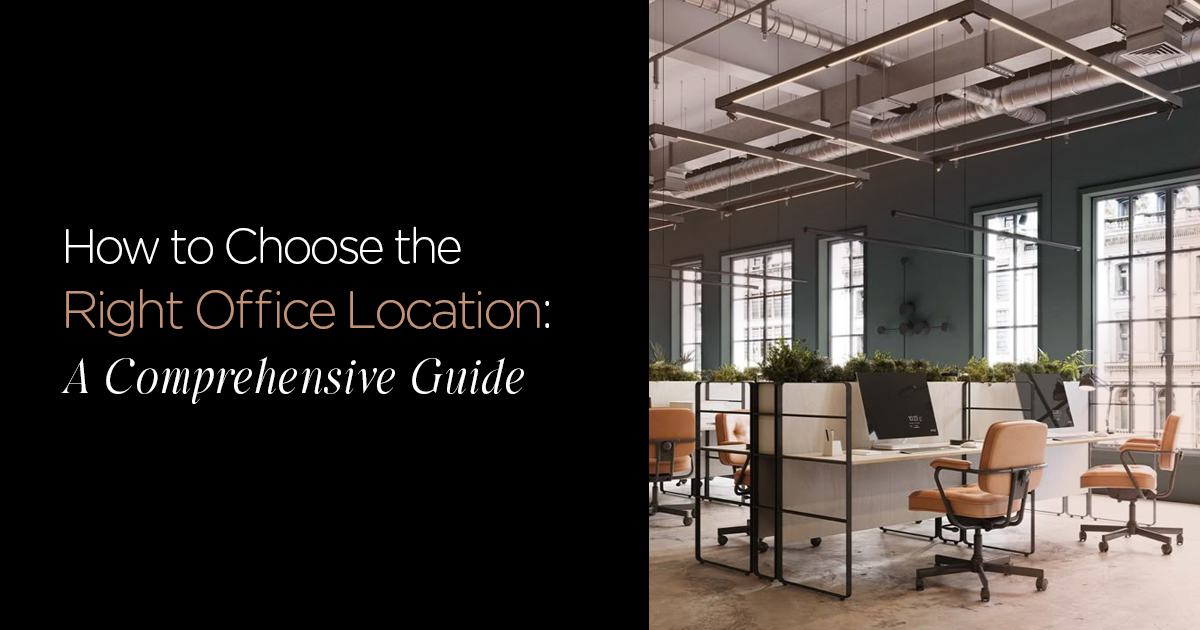
May 13, 2025
How to Choose the Right Office Location: A Comprehensive Guide
Choosing the perfect office location is a strategic decision that influences more than just your company’s mailing address. It shapes the day-to-day experience of your employees, determines how accessible you are to clients, and plays a key role in your ability to attract and retain talent. Taking the time to assess your priorities, understand your business requirements, and evaluate the surrounding environment is essential before settling on an office space that aligns with your vision and objectives.
Factors to Consider When Choosing an Office Space
Choosing a suitable workplace can influence how your team performs and how clients view your business. A good location supports daily operations and future plans. When choosing a business location, consider the following essentials:1. Accessibility & Convenience
The location of your office affects how easy it is for employees to commute and clients to visit:Employee Commute
The daily commute significantly impacts employee satisfaction, productivity, and retention. Picking a business location needs careful and long-term thinking on:- Proximity to residential areas: Choose locations where most of your employees can easily commute. Long commutes increase stress and decrease job satisfaction.
- Public transportation options: Ensure the office is accessible by various public transportation methods (buses, trains, subways). This reduces commuting costs and provides alternatives during bad weather or transportation disruptions.
- Traffic patterns: Research typical traffic flows and congestion times. Locations with reverse-commute patterns can save employees significant travel time.
- Walking and cycling infrastructure: Bike lanes, sidewalks, and pedestrian-friendly environments promote healthier commuting options and reduce carbon footprint.
Client Proximity
Your relationship with clients can be strengthened or challenged by your office location:- Industry clusters: Consider positioning your office within industry hubs where your clients are concentrated. This facilitates face-to-face meetings and networking opportunities.
- Accessibility for visitors: Ensure clients can easily find and access your office. Clear signage, straightforward directions, and proximity to major roads or highways are important.
- Meeting frequency: If client meetings are frequent, prioritise locations that minimise travel time for both parties.
- Professional image: The surrounding area contributes to clients' perception of your business. An address in a reputable business district may enhance your company's credibility.
Parking
Parking considerations are often overlooked, however, they can cause daily frustrations:- Dedicated parking spaces: Calculate the ratio of parking spaces to employees and ensure it meets the organisation's needs.
- Reserved visitor parking: Designated spots for clients and visitors demonstrate hospitality and professionalism.
- Parking costs: Factor in whether parking expenses will be covered by the company or employees.
- Alternative arrangements: Investigate nearby public parking options as overflow solutions during peak times.
- Electric vehicle charging stations: Forward-thinking companies may want access to EV charging infrastructure.
2. Cost & Budget
Rent, utilities, and additional costs play a significant role in determining your office's financial feasibility over time:Rent and Utilities
Office space represents a significant operational expense:- Price per square foot: Compare rates across different neighbourhoods and building types. Newer buildings typically command premium prices but may offer energy efficiency benefits.
- Utility costs: Request historical utility data to estimate monthly expenses for electricity, water, heating, and cooling.
- Hidden costs: Ask about additional expenses like maintenance fees, property taxes (if applicable), insurance requirements, and common area charges.
- Negotiation potential: Market conditions may allow rent concessions, free months, or tenant improvement allowances.
- Total occupancy cost: Calculate the all-in cost, including rent, utilities, maintenance, and other fees for accurate budgeting.
Lease Terms
The structure of your lease agreement can have long-term financial implications:- Lease duration: Shorter leases offer flexibility but usually at higher rental rates. Longer leases provide stability but could become problematic if business needs change.
- Escalation clauses: Understand how and when rent increases will occur throughout the lease term.
- Break clauses: Negotiate terms that allow early termination if necessary, even if it requires a penalty fee.
- Renewal options: Secure the right to extend your lease under predetermined terms.
- Subletting rights: Ensure you can sublet space if your needs change or you are experiencing economic downturns.
- Tenant improvement allowances: Negotiate funds to customise the space to your specifications.
Long-Term Costs
Look beyond immediate expenses to future financial considerations:- Area development plans: Research upcoming infrastructure projects or neighbourhood developments that could affect property values and rental rates.
- Tax incentives: Some municipalities offer tax breaks for businesses relocating to developing areas.
- Insurance rates: Location-specific factors like flood zones or crime rates can impact insurance premiums.
- Maintenance responsibilities: Clearly define which maintenance costs fall to the tenant versus the landlord.
- Energy efficiency: Older buildings may have higher utility costs despite lower rent, affecting the true occupancy cost.
3. Amenities & Lifestyle
Choosing an office near local services and in a safe environment enhances the workplace experience for your team:Local Amenities
Nearby services and facilities enhance the workplace experience:- Dining options: Variety of restaurants, cafes, and food courts for lunch breaks and client meetings.
- Banking and postal services: Convenient access to essential business services.
- Shopping and retail: Access to stores for everyday needs and last-minute purchases.
- Fitness facilities: Nearby gyms or wellness centres support employee health initiatives.
- Green spaces: Parks or outdoor areas provide mental breaks and informal meeting spaces.
- Childcare facilities: Proximity to daycare centres can significantly benefit employees with young children.
Safety & Security
Employee security should be a non-negotiable priority:- Crime statistics: Research local crime rates and types of incidents reported in the area.
- Building security: Evaluate access control systems, security personnel, surveillance cameras, and emergency protocols.
- Lighting: Well-lit parking areas, entrances, and nearby streets improve safety, particularly in winter when it gets dark early.
- Emergency services: Proximity to police stations, fire departments, and hospitals.
- Neighbourhood character: Visit the area at different times of day to assess the general atmosphere and safety levels.
- Natural disaster risk: Consider vulnerability to floods, earthquakes, or other environmental hazards.
Company Culture
Your office location should reflect and support your organisational values:- Brand alignment: Choose a location that reinforces your company's identity and market positioning.
- Work environment: Consider whether a bustling urban centre or a quieter suburban setting better matches your company culture.
- Employee demographics: Select locations that appeal to your workforce's preferences and lifestyles.
- Social opportunities: Areas with after-work venues foster team bonding and networking.
- Architectural style: Modern glass towers versus converted industrial spaces versus suburban office parks each create different atmospheres.
- Mixed-use developments: These often combine office space with residential, retail, and entertainment, creating vibrant work environments.
4. Future Growth & Scalability
Selecting a space with room for expansion ensures your office can adapt as your business grows and evolves:Expansion Potential
Plan for success by ensuring your space can accommodate growth:- Additional space availability: Investigate whether adjacent offices might become available for expansion.
- Flexible floor plans: Open layouts adapt more easily to changing team sizes and configurations.
- Building capacity: Ensure the building infrastructure (elevators, parking, restrooms) can handle increased occupancy.
- Scalable lease options: Negotiate the right of first refusal on adjacent spaces or expansion options.
- Multi-location potential: Consider whether the area has other suitable properties to establish satellite offices.
Market Trends
Location decisions should account for broader economic patterns:- Area growth projections: Research economic development forecasts for potential locations.
- Industry movement: Identify where similar businesses are relocating and why.
- Property value trends: Rising values in an area may indicate improving business conditions but also mean higher future costs.
- Infrastructure development: Planned transportation improvements can enhance accessibility.
- Technology integration: Some newer districts feature advanced digital infrastructure that supports modern business operations.
Talent Pools
Your location affects your ability to attract and retain qualified staff:- Proximity to universities: Access to recent graduates and continuing education opportunities.
- Demographic trends: Some regions are experiencing population growth among specific professional groups.
- Competitive landscape: Understand the local job market conditions and compensation standards.
- Remote work considerations: Even with hybrid models, convenient office locations remain important for in-person collaboration.
Other Considerations
Infrastructure
Technical capabilities can make or break productivity:- Internet connectivity: Verify high-speed fibre optic availability and redundant service providers.
- Power capacity: Ensure the building can support your technology requirements and has backup power systems.
- HVAC systems: Adequate heating, cooling, and ventilation affect comfort and productivity.
- Floor load capacity: Important for businesses with heavy equipment or high-density storage needs.
- Elevator service: Sufficient capacity for employee traffic during peak hours.
- Building age and maintenance: Older buildings may have charm but could require more frequent repairs and updates.
Sustainability
Environmental considerations are increasingly important:- Energy efficiency: LEED-certified or energy-efficient buildings reduce costs and environmental impact.
- Waste management: Effective recycling and waste reduction programmes.
- Water conservation: Low-flow fixtures and rainwater harvesting systems.
- Sustainable transportation: Bike storage, EV charging stations, and public transit access.
- Indoor air quality: Good ventilation systems and safe building materials help improve health by reducing allergens, pollutants, and harmful chemicals in the air.
- Natural lighting: Abundant windows reduce electricity usage and improve employee well-being.
Making the Final Decision
When you've narrowed down your options, consider these evaluation methods:- Create a weighted scorecard: Assign importance values to each factor based on your business priorities.
- Conduct site visits: Visit potential locations at different times and days of the week.
- Gather employee input: Survey staff about their preferences and concerns, especially regarding commuting.
- Financial modelling: Compare comprehensive cost projections across multiple locations.
- Future-proof your decision: Consider how each location aligns with your five-year business plan.




